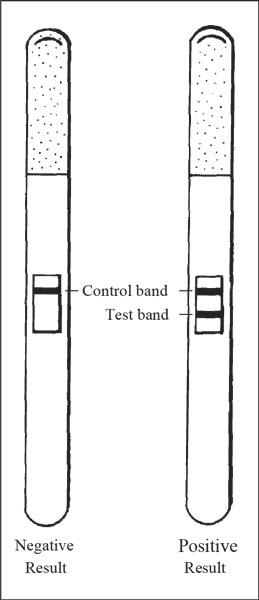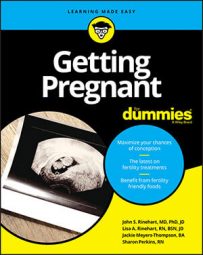 ©Rawpixel.com/Shutterstock.com
©Rawpixel.com/Shutterstock.comThe first home tests were available in the 1970s, and everyone probably would have been a little more squeamish about leaving them in the fridge next to the milk if they had known that they contained prepackaged red blood cells. These tests were very sensitive to movement, so you had to put them someplace quiet and leave them alone for a few hours. When you finally peeked into the fridge, you looked for the dark ring at the bottom of the tube — that’s what appeared if you were pregnant. The clumping together of red blood cells if you were pregnant is what formed the ring.
All the tests, from the 1920s on, measured hCG (human chorionic gonadotropin), the hormone released by the implantation of the embryo and the growing placenta. The newest tests are very sensitive and are able to detect hCG concentrations of 10, 20, or 25mIU/ml (the smaller the number, the higher the sensitivity), which usually occur about ten days after ovulation or about four days prior to the time you would miss your first period. Even though most tests are accurate a few days before your period is due, a negative test at that time may not be accurate. You may have had a late implantation, or you may have ovulated a day or two after you thought you did. Another test should be done a few days later if your period still hasn’t started.
The accuracy of any home pregnancy test depends on how closely you follow the directions, when you ovulated, and the sensitivity of the test. If you test too soon, you may get a false negative.
If you are pregnant, the average level of hCG 10 days post ovulation is 25mIU/ml; it is 50mIU/ml 12 days post ovulation, and 100mIU/ml 14 days after you ovulate. Keep in mind that these numbers are averages; your number may be higher or lower and still be perfectly normal. Also, as with LH kits, the concentration of the urine can play a large role in whether or not the test turns positive. Because any positive value is important, using first morning (most concentrated) urine is a good idea.Blood tests measure hCG with much more accuracy, detecting concentrations less than 5mIU/ml.
How to use HPTs
Home pregnancy tests are available in every drugstore, so if you’re buying in bulk because you’re a compulsive tester, you can hit every grocery store and drugstore in town, and no one will know that you’re compulsive — er, anxious to know! These tests give fast results, usually in two to five minutes. Most tell you to not urinate for four hours before you test so the concentration of the hormone will be high. Some kits suggest that you urinate in a cup and dip the wand into it, and other kits suggest peeing directly on the stick. Some show a positive as a little plus sign; others want you to drag all your friends back in to the bathroom (if you still have any friends left after ovulation) and have them compare the control line to the test line to see whether they match. Usually a positive is indicated by a test line that’s as dark as or darker than the control, and many women drive themselves mad staring at the line trying to determine its exact shade of purple. Some tests now eliminate the “match game” by spelling out, “Yes, you’re pregnant” or some variation if your test is positive.Don’t let the test sit around before looking at it, as some test results will change after an hour or two and will not be accurate. See the following figure for positive and negative results on a home pregnancy test.
 Are you pregnant or not?
Are you pregnant or not?The following table lists the common brands of home pregnancy tests and the lowest number they claim will register a positive result. Sensitivity is measured in units called mIU, which means milli-International Units per milliliter.
| Home Pregnancy Test | Lowest Sensitivity Level |
| AimStick Pregnancy Test Strip | 20 mIU |
| AccuHome Midstream Pregnancy Test | 25 mIU |
| Answer Early Result Pregnancy Test | 25 mIU |
| Answer Pregnancy Test (Cup) | 25 mIU |
| Clearblue +/– | 25 mIU |
| Confirm 1-Step Pregnancy Test | 25 mIU |
| Equate Pregnancy Test | 25 mIU |
| First Response Early Result Pregnancy Test | 25 mIU |
| One Step Be Sure Pregnancy Test | 25 mIU |
| Walgreen Digital | 25 mIU |
| e.p.t. Home Pregnancy Test (one line = not pregnant; two lines = pregnant) | 40 mIU |
| e.p.t. Certainty Digital Test | 40 mIU |
| Fact Plus Pregnancy Test | 40 mIU |
| Clearblue Digital | 50 mIU |
| CVS Cartridge Pregnancy Test | 50 mIU |
| CVS Midstream Pregnancy Test | 50 mIU |
| Drug Emporium Brand Pregnancy Test | 50 mIU |
| e.p.t. +/– Test | 50 mIU |
| early Pregnancy test | 50 mIU |
| RiteAid Brand Pregnancy Test | 50 mIU |
| Target Brand Pregnancy Test | 50 mIU |
| Walmart Brand Pregnancy Test | 50 mIU |
| Walgreens Pregnancy Test | 100 mIU |
False positives
False positive results are rare in home pregnancy tests. Today, HPTs have a greater than 90 percent accuracy. However, you may have a false positive if- You’re taking injections of the hormone hCG to induce ovulation or for any other reason; it takes 14 days for 10,000U of hCG (a standard dose) to completely clear your system.
- You recently had a miscarriage or ectopic pregnancy, and the hCG levels have not dropped to a negative range yet. (This can take up to four weeks.)
You have an extremely rare form of cancer called a choriocarcinoma. Choriocarcinoma occurs in 2–7/100,000 pregnancies. The cancer is a cancer of the cells that would normally form the placenta. This cancer usually follows a full-term birth, miscarriage, or other pregnancy loss. This is a fast-growing cancer, so if you recently had a pregnancy loss of any kind and have a positive home pregnancy test and heavy bleeding, you must see a doctor immediately.
False negatives
The urinary test for pregnancy can show that you are not pregnant when in fact you are. These are called false negatives. The most common reason for this is that you test the urine too soon after ovulation. A second problem arises if you do not wait long enough to read the test. Finally, the urine may be too diluted. Using the first morning urine can decease the false-negative rate. The danger of a false negative is when there is an uncommon problem of an ectopic pregnancy, which is when a pregnancy implants outside the uterus — usually the fallopian tube.If you are undergoing fertility treatment, particularly IVF, you may be cautioned about using HPTs because of the false negative issue. If you use an HPT anyway (we know you might) it is best to check with your clinic before you stop any medication or start a new treatment cycle. Coauthor Lisa knows firsthand how “I got a negative” can turn into “Oh my, you’re pregnant.” She recalls one patient who had finished a Clomid/IUI cycle and reported a negative HPT and a menses. Later, when a baseline ultrasound was done to start the next treatment cycle (an IVF cycle), there was a gestational sac in the uterus! The patient had done the test too early and didn’t explain that her “menses” was only spotting. This is why many clinics require a blood test to confirm whether you are pregnant or not. The real danger with a false negative is that the person assumes one negative test means there is no chance she could be pregnant and misses the presence of an ectopic pregnancy.

